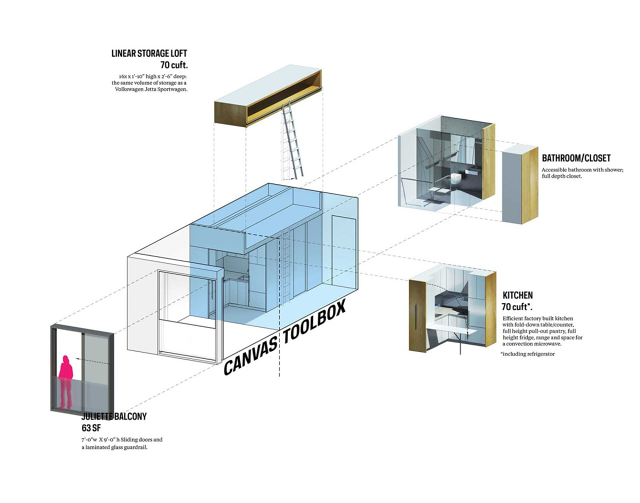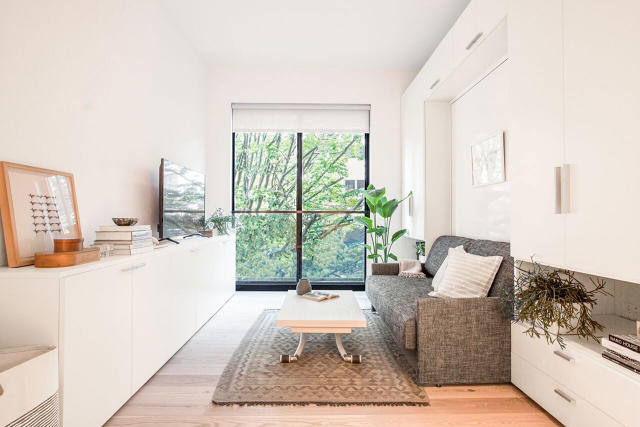Micro apartments: Utopia or Dystopia?
New York city just completed its first micro-unit building. Is the way forward for urban dwelling too tight a squeeze?
December 14, 2015
within the hierarchy of things New York city residents kvetch about, housing ranks near the top. A dearth of affordable residences has the town in a stranglehold and there’s reputedly no end to escalating rents. (good good fortune finding a studio in ny for less than $2,300 per thirty days, the reasonable going price within the borough.) To tackle this downside, former mayor Michael Bloomberg staged a contest in 2012 to design a micro-devices construction. In simply three years, the experimental buildings have hit the market. however is it sufficient to alleviate the affordable housing problem? short solution: it opens the conversation about retooling the town’s provide of residences, nevertheless it’s not exactly a panacea for NYC’s housing complications.
Designed through the Brooklyn-primarily based firm nArchitects, Carmel position (previously often called MyMicro) is situated in Kips Bay, a neighborhood on big apple’s east aspect, acquainted to many as “The location where that movie show that’s not Union square is” and “No, I do now not live in Murray Hill.” Like CitySpaces SOMA, in San Francisco, and Cubix, in Seattle, Carmel location portends the migration of micro units into American cities.

“It really is one small tool in what must be a larger toolbox for addressing the fairly homogeneous housing stock that now we have inherited from the enormous constructing booms when nuclear families prevailed,” Eric Bunge, a predominant, along with Mimi Hoang, at nArchitects says. “young people, old people, heart aged folks—all of them want small devices. And it’s not correlated to any earnings degree. negative folks want it, wealthy individuals need it.”
Modular builder Capsys prefabricated the 9-story construction within the Brooklyn Navy Yard. it’s composed of fifty five flats ranging from 250 to 350 sq. ft with the average being around 300. to achieve this size, Bloomberg issued a mayoral override on the minimal area of an condo—400 square toes—and density necessities; on the other hand, each and every apartment still adheres to ADA accessibility codes.
although diminutive, the micro gadgets aren’t any single-room-occupancy lodge or tenement retread. geared up with hardwood floors, stainless-steel kitchen home equipment, storage lofts, massive home windows, and Juliet balconies, the apartments can be torn from the pages of any modern interiors magazine. The nine-foot-six-inch ceiling heights counterbalance the gadgets’ compact footprint; abundant communal area offers more space to lounge. Some apartments are furnished with house-saving Murphy beds and expanding tables. And for the resident who can’t be stricken to buy their own groceries or do their laundry, there’s a concierge service called Ollie—priced separately—that’ll handle chores.

whereas the housing shortage sparked the competitors, demographic trade influenced the design. The composition of households has continuously morphed over the many years, but the housing stock hasn’t caught up. in step with analysis from the electorate Housing Planning Council—the nonprofit whose research knowledgeable Bloomberg’s AdAPT competition—there are 1.8 million one- and two-particular person households in New York city and simply 1 million studios and one-bedroom residences. Carmel location’s 55 units are just a drop within the bucket, however pose an answer for denser living in a city where buildable land is at a top class.
Affordability is every other driving force. Of the fifty five devices, 33 are market fee—going for $2,500 to $3,000 per 30 days. Eight of the 22 reasonably priced units are precise for previously homeless veterans underneath part 8 vouchers and the remainder 14 entered into the housing lottery. (60,000 individuals utilized.) potential tenants incomes up to $48,000 would pay $950 per month; these incomes up to $seventy eight,650 would be charged $1,490.
“nobody can predict how introduction of this new form of building will have an effect on affordability because it’ll takes time and quantity,” Bunge says. “but the greater framework is that there are so many completely different how to measure affordability. the tip user is a very powerful factor, but on the same degree, additionally value to the city will probably be a consider considering [micro housing].”
Bunge argues that sprawl is dear to town—which in the end trickles all the way down to tax payers—relating to the transportation infrastructure that comes along with it—which is able to quantity to hundreds of thousands and millions of bucks—and bearing in mind denser construction and affordable housing close to current transit—instead of on the fringes of town—might also lend a hand keep costs in check.

Carmel place looks as if a uniquely ny solution, however the takeaways will be applied to other cities being affected by affordability and low emptiness rates. however is the one approach to housing affordability cramming a family of four right into a shoebox? Will all metropolis dwellers say sayonara to space?
“The lesson i think to be learned is looking at how to manner [the housing] drawback,” Bunge says. “This explicit constructing shouldn’t be the one result of taking a look closely at demographics. There are different things we need to do to regulate the housing stock shifting ahead, like, co-housing as an example. There’s a broader lesson in how city agencies are open to analyze-based totally selections. i would say another lesson is to peer how fast the zoning laws can trade thru a course of like this that’s tested with a prototype. a 3rd takeaway for me, personally, is that these apartments can really feel very livable if sure issues are applied, like tall ceilings. We’ve been pronouncing that extent is underrated. all and sundry focuses on floor area. An eight-foot-tall ceiling in a tiny condominium feels truly horrible, but that very same condo with a taller ceiling seems like a loft.”
nArchitects is at present working on a micro-unit constructing in Hong Kong—a metropolis defined with the aid of dense building. Residents are anticipated to move in February 1. “They don’t call them [micro units]; they simply name them apartments, however they’re even smaller,” Bunge says. “The South China Morning put up printed an editorial remaining spring with the title ‘Hong Kong fashion Microflats Arrive in new york‘ so the irony now’s that new york architects like us are constructing an important 30-story tower in Hong Kong and people units are 200 sq. toes.”
Mayor invoice De Blasio has pledged to construct 80,000 affordable homes underneath his 10-year housing plan, which hinges on controversial large swathes of rezoned land in traditionally low-hire neighborhoods like East ny. A 2015 find out about from the Furman center at NYU found that inclusionary zoning—relaxing regulations on developers if they include at percentage of inexpensive units—is most effective financially doable in excessive-appoint neighborhoods.

“In much of the city rents will not be high sufficient to generate high-upward thrust building, so extra density isn’t going to spur [developers to build],” Mark Willis, executive director on the Furman center, informed the Wall side road Journal.
Carmel situation was once wedged into an especially small footprint—just forty five via a hundred and five feet—and in a centrally situated neighborhood. If the city can identify more of these underutilized rather a lot to assemble dense trends where the split between inexpensive and market rate apartments is financially plausible, the Carmel position variation will be repeated. Persuading local govt and condo hunters that this can be a solution will take time. And positive word-of-mouth from residents—presuming it’s indeed positive—will assist.
“There must be a type of culture shift ahead of everyone is on board [with micro apartments], however I additionally suppose that nobody expects everybody to be on board,” Bunge says. “This is only one other possibility in quite a lot of other selections.”
[All Photos: via nArchitects]
fast company , read Full Story
(89)














